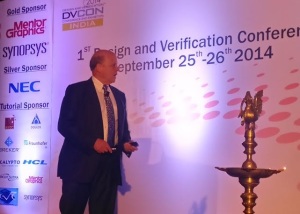According to Dr. Walden C. Rhines, chairman and CEO, Mentor Graphics Corp., verification has to improve and change every year just to keep up with the rapidly changing semiconductor technology. Fortunately, the innovations are running ahead of the technology and there are no fundamental reasons why we cannot adequately verify the most complex chips and systems of the future. He was speaking at the recently held DVCON 2014 in Bangalore, India.

A design engineer’s project time for doing design has reduced by 15 percent from 2007-2014, while the engineer’s time for doing verification had seen 17 percent increase during the same time. At this rate, in about 40 years, all of a designer’s time will be devoted to verification. At the current rate, there is almost no chance of getting a single-gate design correct on first pass!
Looking at a crossover of verification engineers vs. designer engineers, there is a CAGR designers of 4.55 percent, and for CAGR verifiers, it is 12.62 percent.
The on-time completion remains constant, as we look at the non-FPGA project’s schedule completion trends, which are: 67 percent behind schedule for 2007, 66 percent behind schedule for 2010, 67 percent behind schedule for 2012, and 59 percent behind schedule for 2014. There has been an increase in the average number of embedded processors per design size, moving from 1.12 to 4.05.
Macro trends
Looking at the macro trends, there has been standardization of verification languages. SystemVerilog is the only verification language growing. Now, interestingly, India leads the world in SystemVerilog adoption. It is also remarkable that the industry converged on IEEE 1800. SystemVerilog is now mainstream.
There has been standardization in base class libraries as well. There was 56 percent UVM growth between 2012 and 2014, and 13 percent is projected growth in UVM the next year. Again, India leads the world in UVM adoption.
The second macro trend is standardization of the SoC verification flow. It is emerging from ad hoc approaches to systematic processes. The verification paradox is: a good verification process lets you get the most out of best-in-class verification tools.
The goal of unit-level checking is to verify that the functionality is correct for each IP, while achieving high coverage. Use of advanced verification techniques has also increased from 2007 to 2014.
Next, the goal of connectivity checking is to ensure that the IP blocks are connected correctly, a common goal with IP integration and data path checking.
The goal of system-level checking is performance, power analysis and SoC functionality. Also, there are SoC ‘features’ that need to be verified.
A third macro trend is the coverage and power across all aspects of verification. The Unified Coverage Interoperability Standard or UCIS standard was announced at DAC 2012 by Accellera. Standards accelerate the EDA innovation!
The fourth trend is active power management. Now, low-power design requires multiple verification approaches. Trends in power management verification include things like Hypervisor/OS control of power management, application-level power management, operation in each system power state, interactions between power domains, hardware power control sequence generation, transitions between system power states, power domain state reset/restoration, and power domain power down/power up.
Macro enablers in verification
Looking at the macro enablers in verification, there is the intelligent test bench, multi-engine verification platforms, and application-specific formal. The intelligent test bench technology accelerates coverage closure. It has also seen the emergence of intelligent software driven verification.
Embedded software headcount surges with every node. Clock speed scaling slows the simulation performance improvement. Growing at over 30 percent CAGR from 2010-14, emulation is the fastest growing segment of EDA.
As for system-level checking, as the design sizes increase emulation up, the FPGA prototyping goes down. The modern emulation performance nmakes virtual debug fast. Virtual stimulus makes emulator a server, and moves the emulator from the lab to the datacenter, thereby delivering more productivity, flexibility, and reliability. Effective 100MHz embedded software debug makes virtual prototype behave like real silicon. Now, integrated simulation/emulation/software verification environments have emerged.
Lastly, for application-specific formal, the larger designs use more formal. The application-specific formal includes checking clock domain crossings.
You must be logged in to post a comment.